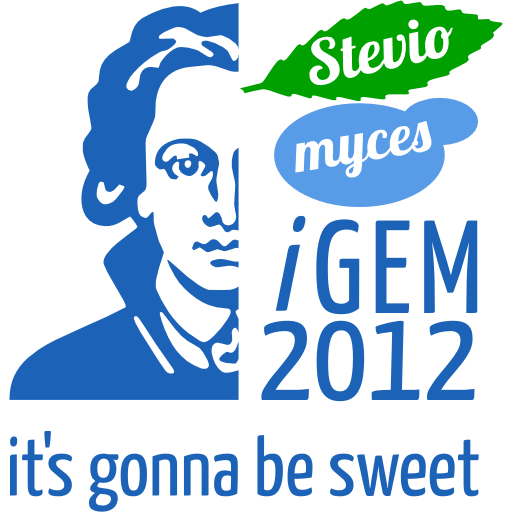Team:Frankfurt
From 2012.igem.org
| Home | Team | Project | Organisms | New Yeast RFC | Notebook | Registered Parts | Modeling | Safety | Attributions | Official Team Profile |
|---|
Welcome to our page and greetings from the Goethe University Frankfurt am Main. In the near future we will add some basic information about our project, the people involved and the place we study at.
Current Project Description
Many widespread diseases such as obesity, type 2 diabetes, caries et cetera, especially common in western countries, are directly or indirectly linked to high sugar consumption. In order to reduce calorie intake and minimize health impact, many artificial sweeteners have been developed over the past decades, though virtually all with specific downsides. A recent example of a family of prospective sweeteners of plant origin are Rebaudiosides, diterpene glycosides from paraguyan herb Stevia rebaudiana, which has been used regionally for probably centuries. Its extremely sweet tasting leaves and stems can be used dried, but are more recently commercially extracted for their Rebaudioside contents. The Rebaudiosides are a family of differently glycosylated Steviol diterpenes, of which Rebaudioside A has the best properties in taste and sweetness, though other members of this family have varying taste deficiencies such as bitterness.
Therefore, we aim to develop biobricked pathway expressing all necessary genes for Rebaudioside A production in common baker's yeast Saccharomyces cerevisae, a well known, safe organism used in food production for millenia. As a precursor for the diterpene Steviol is geranylgeranyl pyrophosphate (GGPP), an intermediate of the mevalonate pathway and the steroid metabolism, we plan to overexpress certain key enzymes of this pathway in order to create a favorable amount of educts for Steviol biosynthesis, as literature research hinted at this particular bottleneck. Furthermore, we aim to clone, biobrick and express the enzymes for a bifunctional cyclase from Gibberella fujikuroi catalyzing a two step cyclisation from GGPP to ent-Kaurene, the ent-Kaurene oxidase, as well from Gibberella fujikuroi, catalyzing the reaction from ent-Kaurene to ent-Kaurenoic acid, and a ent-Kaurenoic acid hydroxylase from Stevia rebaudiana, catalyzing the final step producing Steviol. Finally, we will try introduce certain uracil-glycosil transferases (UGTs) from Stevia rebaudiana, catalyzing various glycosilation reactions necessary to produce Rebaudiosides. As one UGT believed to be necessary for Rebaudioside A production is not yet known, we might conduct experiments to find this particular UGT or a viable substitute.
Basing upon a microorganism producing stevia sweetener, other problems such as purification and product recovery might be improved biotechnologically, and stevia sweetener producing biobricks might prove useful in other organisms and use scenarios.
 "
"
